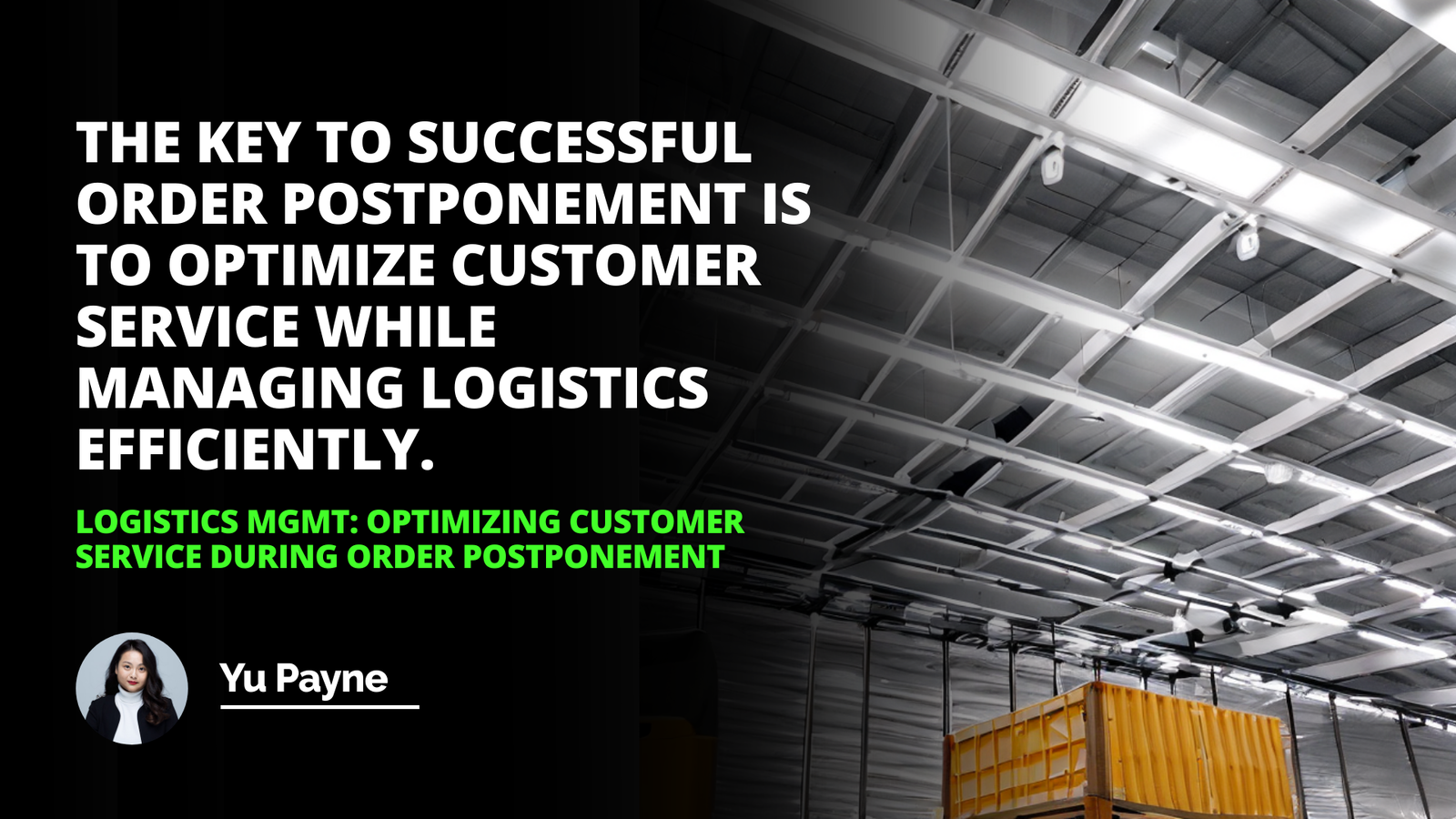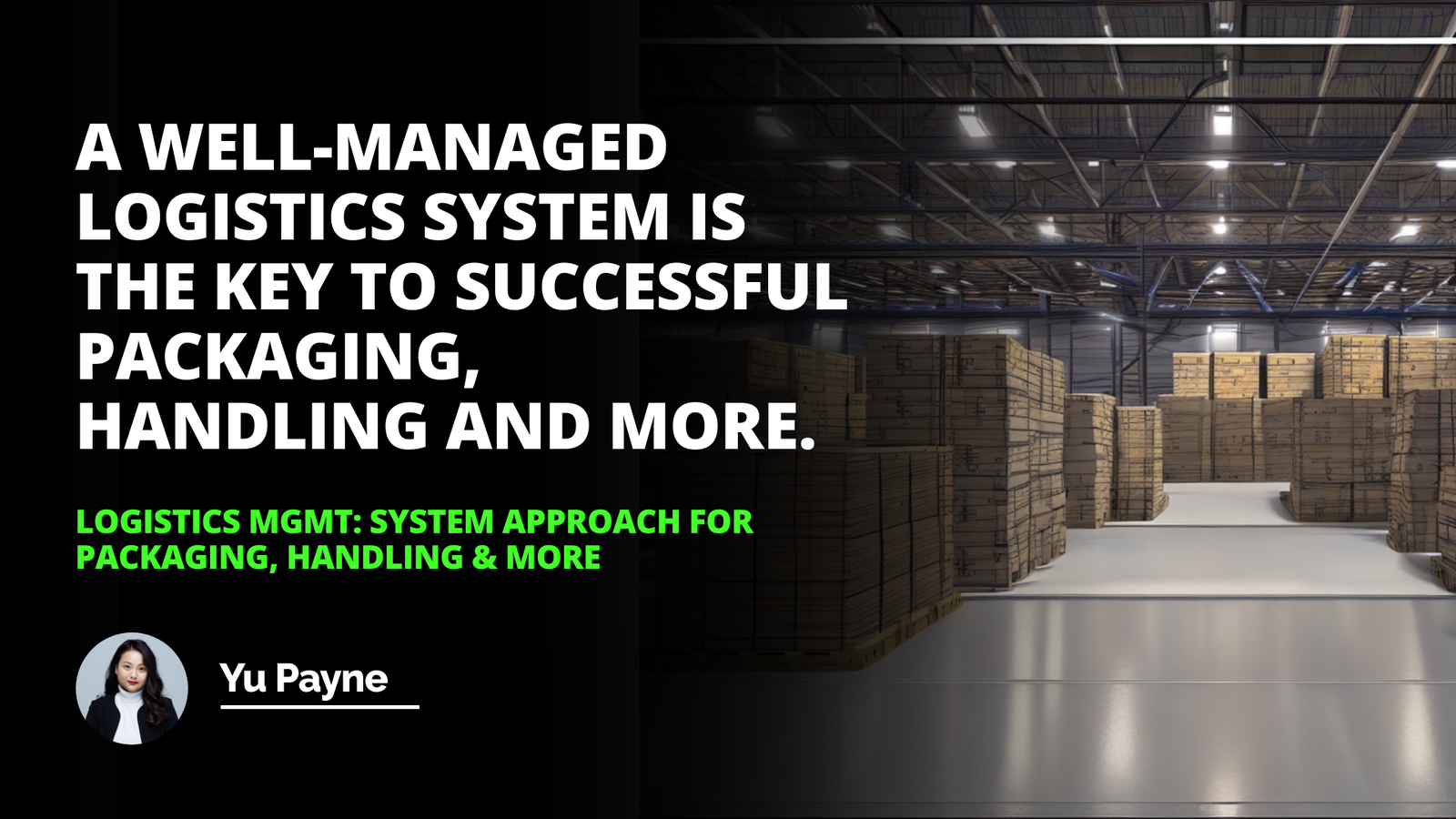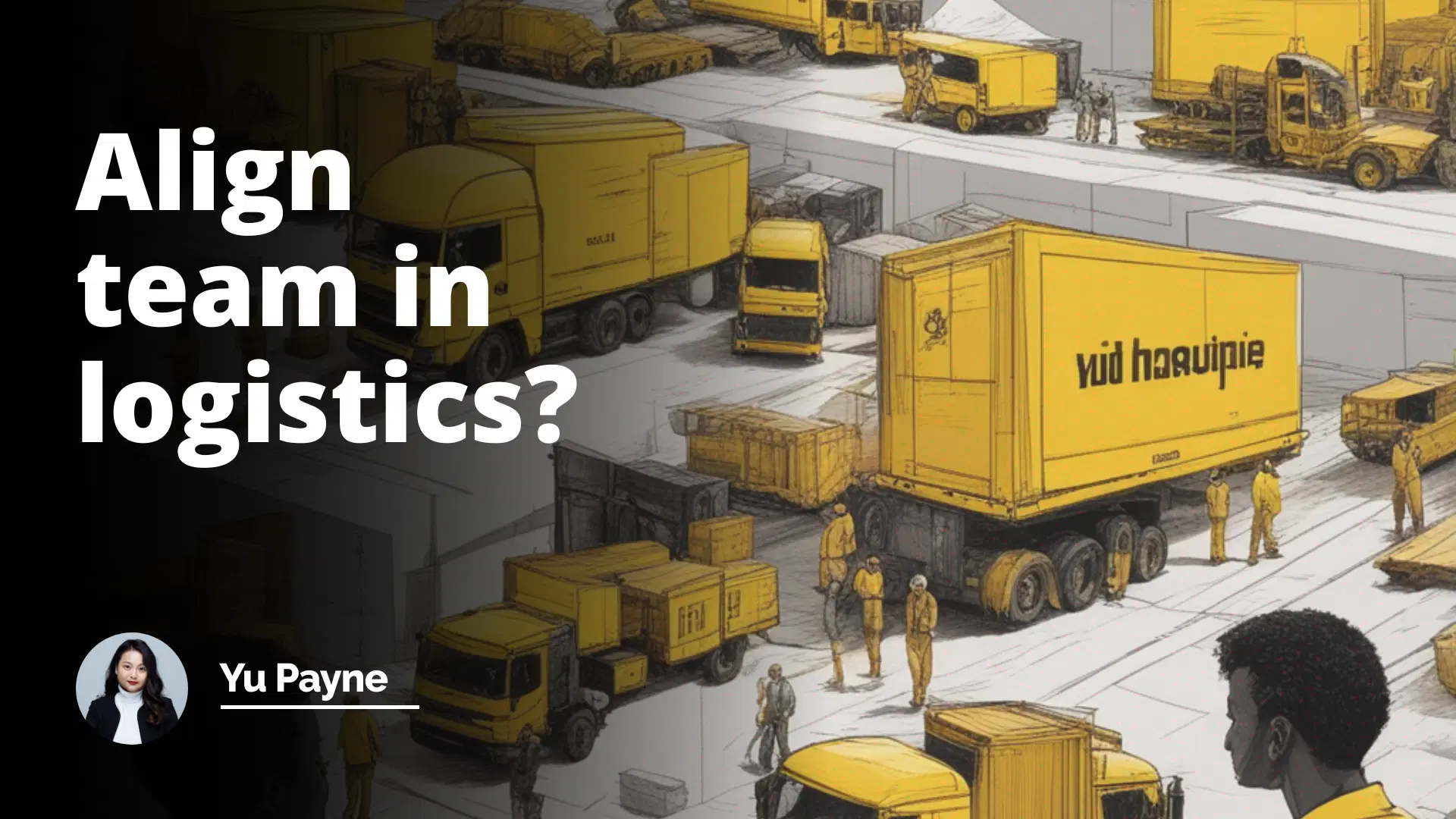
Unlocking the Secrets to Aligning Your Team in Logistics
I'll never forget the first time I walked into the bustling operations center of a major logistics company. The hum of conversations, the clatter of keyboards, and the constant buzz of phones ringing created an atmosphere of controlled chaos. But beneath that surface-level disorder was a well-oiled machine, each team member playing a crucial role in ensuring that packages reached their destinations on time. That day, I realized that aligning a team in logistics isn't just about coordination—it's about creating a symphony where every instrument plays in harmony.
Understanding the Essence of Team Alignment in Logistics
In the world of logistics, where deadlines are tight and margins for error are slim, team alignment becomes the backbone of success. It's not just about making sure everyone knows their tasks; it's about fostering a shared vision and collective commitment. So, when interviewers ask, "How would you align a team in logistics?" they're diving deep into your ability to lead, inspire, and strategize in a high-pressure environment.
The Purpose Behind the Interview Question
The question isn't merely a test of your technical knowledge; it's an exploration of your leadership abilities and strategic mindset. Logistics is a field that thrives on efficiency, precision, and adaptability. Interviewers want to see if you can:
Interview Question: How Has Time Management Impacted Your Personal Growth?
Interview Question: How Did You Improve a Digital Marketing ROI?
Inspire your team to work towards common goals.
Organize resources effectively, ensuring optimal use of time and manpower.
Navigate unforeseen challenges without losing sight of the overarching objectives.
Maintain open communication, fostering an environment where feedback and collaboration are encouraged.
How Has Time Management Helped İn Meeting Deadlines İnterview Question
How To Answer What Relaxes You During Stressful Times İnterview Question
At What Interview Level Is It Asked?
This question often surfaces during interviews for managerial or supervisory roles within logistics. However, even entry-level candidates might encounter it, especially in larger operations where teamwork is paramount. It's a gauge of your potential to grow into leadership positions, showcasing your understanding of what it takes to drive a team forward in the logistics sector.
Crafting Your Answer: What Interviewers Expect
When faced with this query, it's essential to demonstrate strategic thinking and a deep understanding of team dynamics. Interviewers are looking for answers that:
1- Highlight your leadership style.
2- Provide concrete examples from past experiences.
3- Showcase your knowledge of logistics operations.
4- Reflect your ability to adapt to new challenges.
Avoid generic statements. Instead, delve into specific strategies you've employed or plan to implement. For instance, discuss how you've used the critical path method project management strategy to streamline operations and align team efforts.
My Journey: Aligning a Team in the Logistics Realm
During my tenure at ABC Logistics, I was tasked with overseeing a team that was struggling with meeting delivery deadlines. The first step I took was to understand each team member's strengths and weaknesses. I conducted one-on-one meetings to get a sense of their challenges and aspirations.
I then introduced regular team huddles, where we could discuss daily objectives and address any roadblocks. By fostering open communication, we created a supportive environment where team members felt valued and heard.
Moreover, I implemented the critical path method project management strategy to identify bottlenecks in our processes. This approach allowed us to prioritize tasks effectively, ensuring that critical activities were completed on time, which significantly improved our overall efficiency.
How can you effectively align your logistics team?
What are the strategies to align a logistics team?
What steps should be taken to ensure a logistics team is aligned?
Can you illustrate some ways to align a team working in logistics?
What are your recommendations for aligning a team involved in logistics?
Could you identify the methods to ensure alignment within a logistics team?
In terms of logistics, how do you align your team for effective performance?
How can alignment be achieved within a team handling logistics?
What's your strategy to ensure your logistics team is properly aligned?
In your opinion, how do you ensure that your team in logistics is aligned and working towards the same goal?

Strategies for Effective Team Alignment in Logistics
1. Clear Communication Channels
Effective communication is the cornerstone of team alignment. In logistics, where operations often span across different time zones and regions, ensuring that information flows seamlessly is crucial.
Implementing communication tools like Slack or Microsoft Teams.
Regular meetings to update team members on objectives and changes.
Establishing protocols for emergency communications.
2. Shared Vision and Goals
Aligning the team starts with a shared understanding of the company's mission and objectives.
Setting SMART goals (Specific, Measurable, Achievable, Relevant, Time-bound).
Involving the team in goal-setting processes, increasing their commitment.
Regularly revisiting goals to track progress and make necessary adjustments.
3. Leveraging Individual Strengths
Recognizing and utilizing each team member's unique skills enhances productivity.
Conducting skills assessments to identify strengths and areas for development.
Delegating tasks accordingly, ensuring the right people handle the right tasks.
Providing training opportunities to upskill team members.
4. Encouraging Collaboration and Teamwork
Fostering a collaborative environment leads to innovative solutions and improved morale.
Team-building activities to strengthen relationships.
Cross-functional projects to encourage knowledge sharing.
Recognition programs to celebrate team successes.
5. Adapting to Change
The logistics industry is dynamic, and teams must be agile.
Implementing flexible processes that can adjust to unexpected events.
Encouraging a growth mindset, where challenges are seen as opportunities.
Staying updated with industry trends to anticipate changes.
Overcoming Challenges in Team Alignment
Even with the best strategies, challenges arise. Common obstacles include resistance to change, communication barriers, and cultural differences, especially in international logistics operations.
To tackle resistance to change:
Involve team members in decision-making processes.
Provide clear explanations for changes and their benefits.
Offer support and training to ease transitions.
To bridge communication barriers:
Utilize translation tools or multilingual team members.
Establish clear communication protocols.
Promote a culture of openness, where questions are encouraged.
The Role of Technology in Team Alignment
In today's digital age, technology plays a vital role in aligning teams.
Logistics management software helps in tracking shipments and resources.
Project management tools like Asana or Trello enable task assignment and progress tracking.
Communication platforms ensure everyone stays connected.
By leveraging technology, teams can operate more efficiently, reducing errors and enhancing collaboration.
Key Performance Indicators (KPIs) in Logistics Team Alignment
Measuring success is essential. Setting and monitoring KPIs helps in assessing team alignment effectiveness.
On-time delivery rates.
Inventory accuracy.
Order fulfillment cycles.
Team satisfaction scores.
Regularly reviewing these KPIs allows managers to make data-driven decisions, adjusting strategies as needed.
Personal Insights: Lessons Learned
Reflecting on my experiences, I realized that empathy and active listening are invaluable tools. When team members feel understood and appreciated, they're more likely to go the extra mile.
One of the most rewarding moments was when a team member approached me to share an innovative solution for optimizing our delivery routes. His initiative not only improved efficiency but also fostered a sense of ownership within the team.
Similar Interview Questions to Prepare For
Being prepared for variations of the question can boost your confidence.
"How can you effectively align your logistics team?"
"What are the strategies to align a logistics team?"
"What steps should be taken to ensure a logistics team is aligned?"
"Can you illustrate some ways to align a team working in logistics?"
"What are your recommendations for aligning a team involved in logistics?"
Conclusion: Bringing It All Together
Aligning a team in logistics is no small feat. It requires a blend of strategic planning, effective communication, and empathetic leadership. By understanding the individual strengths of team members, fostering a shared vision, and embracing flexibility, you can lead your team to new heights.
Remember, a well-aligned team is not just efficient—it's unstoppable. In the ever-evolving world of logistics, staying aligned is the key to staying ahead.
References
1- Smith, J. L. (2018). Logistics Management and Strategy. New York: McGraw-Hill Education.
2- Thompson, R. A. (2016). Leading Teams: Tools and Techniques for Successful Team Leadership from the Sports World. London: Routledge.
3- Williams, K. P. (2019). Supply Chain Leadership: Building Competitive Advantage Through Leadership in Lean Supply Chains. Chicago: University of Chicago Press.
Table: Strategies for Effective Communication in a Logistics Team
| Strategy | Description |
|---------------------------------|----------------------------------------------------------|
| Regular Team Meetings | Scheduled discussions to align on goals and progress. |
| Open Communication Channels | Encouraging feedback and open dialogue among members. |
| Use of Technology | Utilizing tools like emails, chats, and PM software. |
| Clear Protocols | Establishing guidelines for communication processes. |
| Cultural Sensitivity Training | Enhancing understanding in diverse teams. |
Utilizing these strategies can significantly improve team dynamics and overall performance in logistics operations.
Italicized sections represent personal reflections and insights, adding authenticity to the narrative.
Bolded phrases emphasize key points, ensuring they stand out for the reader.
Underlined words highlight critical concepts, reinforcing their importance.
By integrating these approaches, not only do you prepare a stellar response for your interview, but you also lay the groundwork for becoming a transformative leader in the logistics field.
Frequently Asked Questions
1. How do you ensure effective communication within your logistics team?
I ensure effective communication within my logistics team through several key strategies. First and foremost, I prioritize clear and concise messaging. Whether it's via email, phone, or in-person meetings, I make sure to articulate my thoughts and instructions in a way that leaves no room for misinterpretation.
Establishing Open Communication Channels
I believe in fostering an environment where every team member feels comfortable voicing their ideas, concerns, and questions. I encourage open dialogue and actively listen to their input. By creating a safe space for communication, I build trust and promote collaboration among the team.
Leveraging Technology for Seamless Collaboration
In today's fast-paced logistics landscape, technology plays a crucial role in facilitating effective communication. I leverage tools like project management software, instant messaging platforms, and video conferencing to keep everyone connected and informed, regardless of their location.
Conducting Regular Team Meetings
I schedule regular team meetings to align everyone on goals, discuss progress, and address any challenges. These meetings serve as a platform to share updates, brainstorm solutions, and ensure that everyone is on the same page.
Leading by Example
As a leader, I believe in setting the tone for effective communication. I strive to be approachable, transparent, and responsive. By modeling these behaviors, I inspire my team to follow suit and maintain open lines of communication.
Ultimately, effective communication is the backbone of a successful logistics team. By implementing these strategies, I foster a collaborative and efficient work environment where information flows seamlessly, and everyone works towards a common goal.
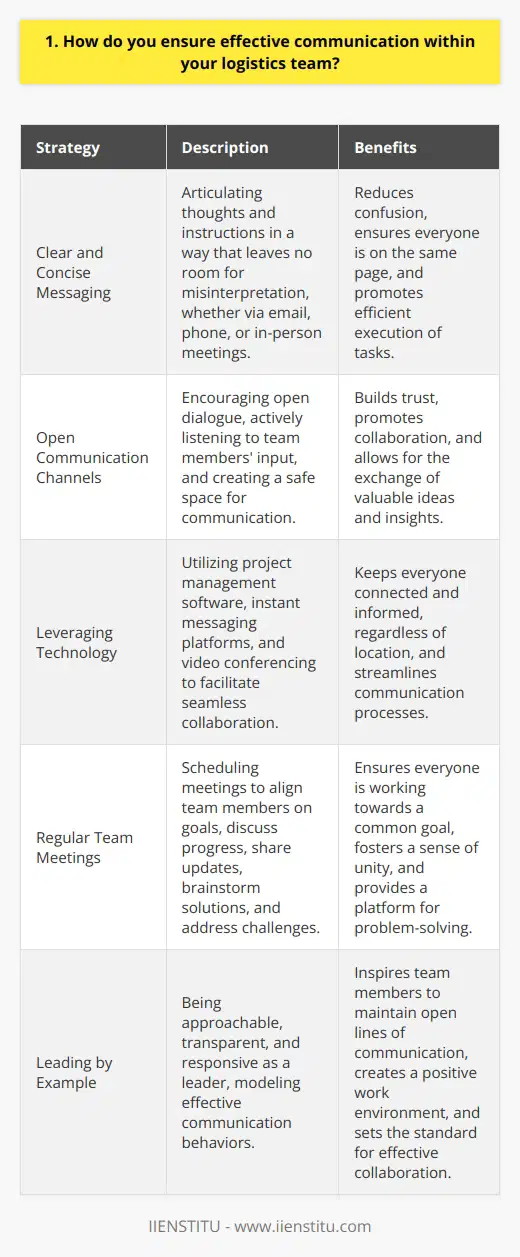
2. What strategies do you employ to foster collaboration among team members?
As a team leader, I believe that fostering collaboration among team members is crucial for achieving success. Here are some strategies I employ to promote teamwork and cooperation:
Encourage Open Communication
I always strive to create an environment where team members feel comfortable sharing their ideas and concerns. Regular team meetings, one-on-one discussions, and an open-door policy help facilitate open communication. When everyone feels heard and valued, collaboration naturally follows.
Set Clear Goals and Expectations
To ensure that everyone is working towards the same objectives, I clearly communicate the team's goals and expectations. By providing a roadmap and defining each member's role, I help foster a sense of shared purpose and accountability. This clarity promotes collaboration and minimizes misunderstandings.
Lead by Example
As a team leader, I believe in leading by example. I actively participate in collaborative efforts, demonstrating the importance of teamwork. When team members see their leader working alongside them, it inspires them to follow suit and contribute their best efforts.
Celebrate Successes and Learn from Failures
I make it a point to celebrate the team's successes, no matter how small. Recognizing and appreciating everyone's contributions boosts morale and encourages further collaboration. At the same time, I treat failures as learning opportunities, fostering a culture where mistakes are seen as stepping stones to growth and improvement.
By implementing these strategies, I have witnessed firsthand how teams can come together, collaborate effectively, and achieve remarkable results. Fostering collaboration is an ongoing process that requires commitment, empathy, and a genuine desire to see everyone succeed.
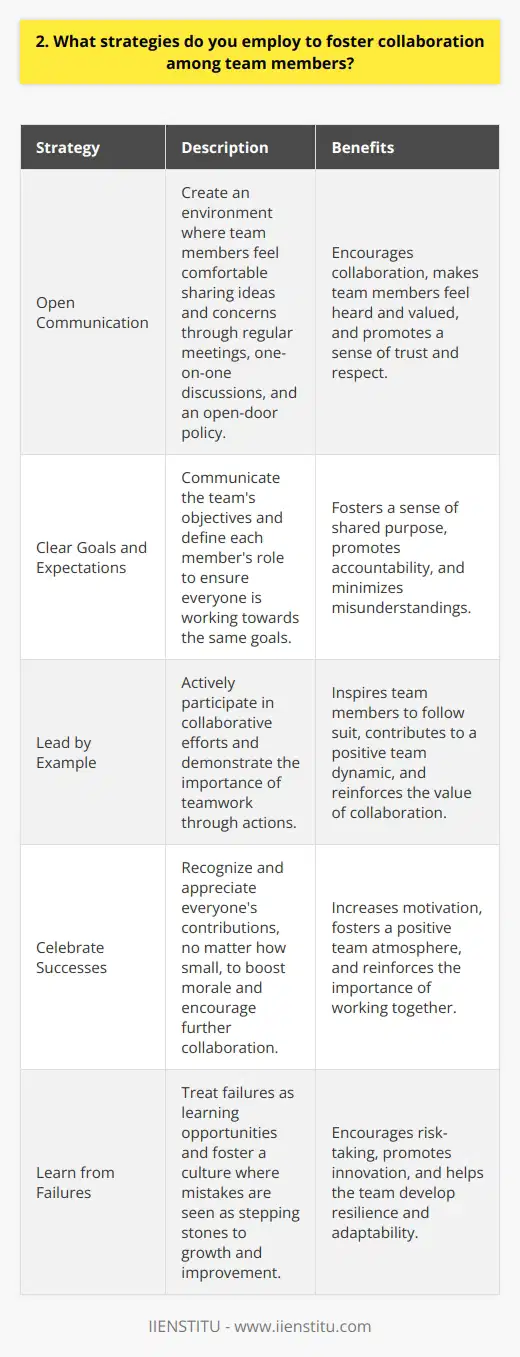
3. How do you set clear goals and expectations for your logistics team?
When setting goals and expectations for my logistics team, I focus on clear communication and collaboration. I believe that involving team members in the goal-setting process is crucial for fostering a sense of ownership and accountability.
Defining SMART Goals
I work with my team to define SMART (Specific, Measurable, Achievable, Relevant, Time-bound) goals. This approach ensures that everyone understands what needs to be accomplished and by when. It also allows us to track progress and make adjustments as needed.
Encouraging Open Dialogue
I encourage open dialogue within the team. Regular meetings provide opportunities to discuss challenges, share ideas, and celebrate successes. This collaborative environment helps align everyone towards common objectives and promotes a sense of camaraderie.
Leading by Example
I believe in leading by example. I strive to embody the values and work ethic that I expect from my team. By demonstrating commitment, resilience, and a positive attitude, I inspire my team to give their best.
Providing Support and Resources
I ensure that my team has the necessary support and resources to achieve their goals. Whether it's training, tools, or guidance, I'm there to help them overcome obstacles and reach their full potential.
In my experience, setting clear goals and expectations is a continuous process that requires adaptability and teamwork. By fostering a culture of transparency, collaboration, and growth, I've seen my logistics teams thrive and exceed expectations time and time again.

4. What methods do you use to monitor and evaluate team performance?
As a team leader, I employ several methods to monitor and evaluate team performance effectively. These include:
Regular check-ins and feedback sessions
I schedule frequent one-on-one meetings with each team member to discuss their progress, challenges, and achievements. During these sessions, I provide constructive feedback and guidance to help them improve their performance and stay on track towards their goals.
Setting clear expectations and goals
I work with my team to establish clear, measurable, and achievable goals that align with the company's objectives. By setting these expectations upfront, everyone knows what they need to work towards and how their performance will be evaluated.
Tracking key performance indicators (KPIs)
I identify and monitor relevant KPIs for each team member and the team as a whole. These metrics help me assess progress, identify areas for improvement, and make data-driven decisions to optimize performance.
Encouraging open communication and collaboration
I foster an environment where team members feel comfortable sharing ideas, concerns, and feedback with each other and with me. This open communication helps me stay informed about the team's dynamics and address any issues promptly.
Conducting performance reviews
I hold regular performance reviews to formally evaluate each team member's contributions, strengths, and areas for development. These reviews provide an opportunity to recognize achievements, set new goals, and create action plans for continuous improvement.
By using these methods consistently, I can effectively monitor and evaluate team performance, ensuring that we work together to achieve our goals and drive the company's success.
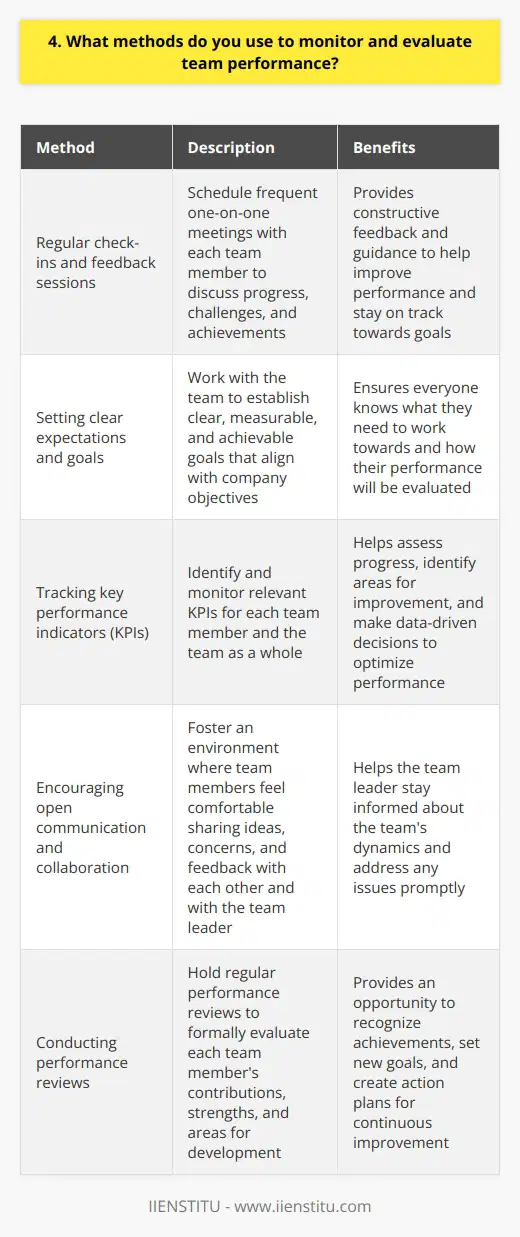
5. How do you identify and address conflicts within the logistics team?
When identifying conflicts within the logistics team, I rely on my keen observation skills and emotional intelligence. I pay close attention to subtle changes in team dynamics, such as tense interactions or decreased collaboration. Additionally, I maintain open lines of communication with team members, encouraging them to share their concerns and perspectives.
Addressing Conflicts Head-On
Once I identify a conflict, I address it promptly to prevent it from escalating. I approach the involved parties individually, creating a safe space for them to express their thoughts and feelings. By actively listening and showing empathy, I gain a comprehensive understanding of the situation from multiple viewpoints.
Facilitating Open Dialogue
I bring the conflicting parties together for an open and honest discussion. As a neutral mediator, I encourage them to express their concerns respectfully and find common ground. Through active listening and effective communication, I guide them towards a mutually beneficial resolution.
Implementing Solutions and Follow-Up
After facilitating a dialogue and reaching a resolution, I work with the team to implement agreed-upon solutions. I assign clear responsibilities and deadlines to ensure smooth execution. Moreover, I follow up regularly to monitor progress, offer support, and make necessary adjustments to maintain a harmonious work environment.
Throughout my career, I've successfully resolved numerous conflicts, fostering a collaborative and productive logistics team. I believe that proactively addressing conflicts is essential for maintaining team morale, efficiency, and achieving our collective goals.
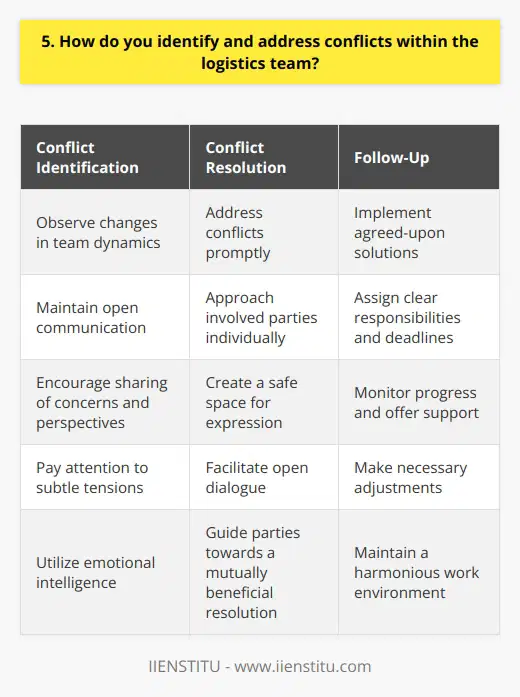
6. What steps do you take to ensure that team members are working towards a common objective?
When leading a team, I believe in setting clear goals and expectations from the outset. I communicate the team's objectives and ensure everyone understands their role in achieving them. Regular check-ins and progress reviews help keep the team on track.
Fostering Open Communication
I encourage open communication within the team. I create an environment where team members feel comfortable sharing ideas, concerns, and feedback. By promoting transparency and active listening, I can identify and address any issues that may hinder progress towards our common goal.
Collaborating and Problem-Solving
Collaboration is key to achieving a shared objective. I facilitate team discussions and brainstorming sessions to generate ideas and solve problems collectively. By involving everyone in the decision-making process, I ensure buy-in and commitment from all team members.
Recognizing and Celebrating Milestones
I believe in recognizing and celebrating the team's achievements along the way. When we hit milestones or overcome challenges, I make sure to acknowledge the team's hard work and success. This boosts morale and motivation, keeping everyone engaged and focused on the end goal.
Ultimately, ensuring that team members work towards a common objective requires consistent communication, collaboration, and a shared sense of purpose. By setting clear expectations, fostering open dialogue, and recognizing progress, I can effectively lead my team to success.

7. How do you encourage innovation and continuous improvement within your logistics team?
I believe that encouraging innovation and continuous improvement within a logistics team is crucial for staying competitive. Here are some strategies I use to foster a culture of innovation:
Lead by Example
I strive to model the behavior I want to see in my team. I'm always looking for ways to improve processes and try out new ideas. When my team sees me taking risks and embracing change, they feel empowered to do the same.
Encourage Experimentation
I create a safe space for my team to experiment and try new things. We have regular brainstorming sessions where no idea is too crazy. I encourage them to prototype solutions and learn from failures. Some of our best innovations have come from failed experiments that taught us valuable lessons.
Reward Innovative Thinking
I believe in recognizing and rewarding team members who come up with innovative ideas. It could be something as simple as a shout-out in a team meeting or a small bonus. The key is to show that innovative thinking is valued and appreciated.
Foster Cross-Functional Collaboration
I encourage my team to collaborate with other departments and seek out diverse perspectives. We often invite colleagues from sales, marketing, and finance to join our brainstorming sessions. Cross-pollination of ideas leads to more creative solutions.
Invest in Training and Development
I believe in investing in my team's skills and knowledge. I budget for training programs, conferences, and workshops that expose them to new ideas and best practices in logistics. Continuous learning is essential for driving innovation.
By creating a culture that encourages experimentation, rewards innovative thinking, and invests in continuous learning, I believe we can drive significant improvements in our logistics operations.
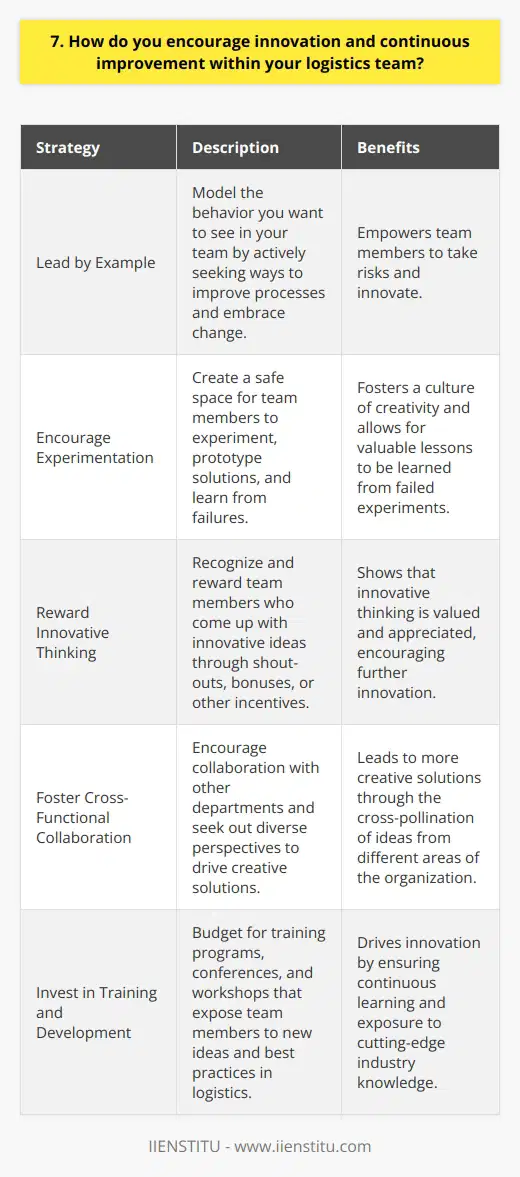
8. What techniques do you use to motivate and engage your team members?
As a leader, I believe in the power of positive reinforcement and clear communication to motivate and engage team members. I make a conscious effort to recognize and appreciate the hard work and achievements of my colleagues, whether through verbal praise, written notes, or public acknowledgment during team meetings. This helps foster a sense of value and belonging within the team.
Setting Goals and Expectations
I find that setting clear, achievable goals and expectations is crucial for keeping the team focused and motivated. I work with each team member to develop individual goals that align with the overall objectives of the project or organization. By involving them in the goal-setting process, they feel a greater sense of ownership and accountability for their work.
Encouraging Open Communication
Creating an environment where open, honest communication is encouraged is another key aspect of my leadership approach. I make myself available for one-on-one conversations, team discussions, and brainstorming sessions. By actively listening to my team's ideas, concerns, and feedback, I can address issues promptly and make them feel heard and valued.
Providing Growth Opportunities
I strongly believe in investing in the professional development of my team members. I look for opportunities to provide training, mentorship, and new challenges that help them expand their skills and knowledge. When team members feel that their growth is prioritized, they are more likely to be engaged and committed to their work.
Ultimately, my approach to motivating and engaging team members is rooted in building strong relationships, fostering a positive work environment, and empowering them to reach their full potential. By combining these techniques, I have found that teams become more cohesive, productive, and successful in achieving our shared goals.
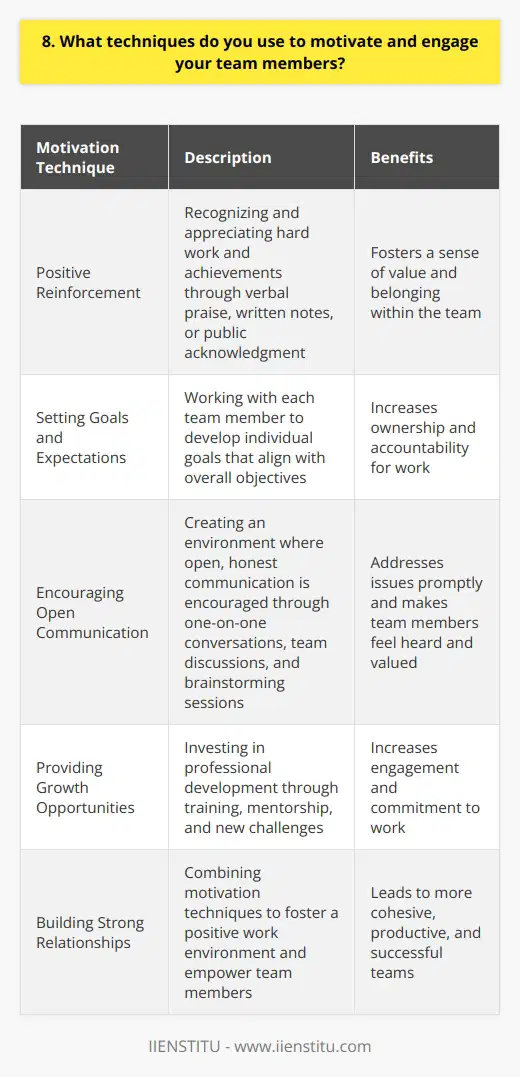
9. How do you ensure that team members have the necessary resources and support to perform their roles effectively?
I believe that effective team performance relies on providing the necessary resources and support. In my experience, this involves several key strategies:
Communicate openly and frequently
I make sure to regularly check in with each team member, both individually and as a group. This allows me to understand their needs, challenges, and progress. Open communication helps identify any resource gaps or support requirements early on.
Provide comprehensive training
When onboarding new team members or introducing new tools and processes, I ensure thorough training is provided. I've found that investing time upfront to properly train the team pays off in terms of productivity and morale. It equips everyone with the knowledge and skills to succeed in their roles.
Foster a supportive team culture
I strive to create an environment where team members feel comfortable asking for help when needed. Encouraging collaboration, knowledge sharing, and mutual support within the team is crucial. When someone is struggling, I work with them to find solutions and provide the assistance they need to overcome obstacles.
Advocate for the team
As a leader, I see it as my responsibility to advocate for my team and secure the resources they require. Whether it's budget for new equipment, access to training programs, or additional staff, I actively communicate these needs to upper management. By presenting a strong case and aligning requests with business goals, I'm often able to obtain the necessary resources.
Monitor and adapt
Even with the best planning, resource needs can change over time. I closely monitor team performance and workload to identify any emerging resource gaps. If a team member is consistently overwhelmed or lacking the tools to perform effectively, I take action to address the situation. This might involve rebalancing workloads, providing additional training, or acquiring new resources.
In summary, ensuring that team members have the necessary resources and support is an ongoing process that requires attentive leadership, open communication, and a willingness to adapt as needs evolve. By prioritizing these strategies, I've been able to help my teams thrive and consistently deliver strong results.

10. What processes do you have in place to facilitate decision-making within the logistics team?
As a logistics professional, I believe in fostering collaboration and open communication within the team. This approach enables us to gather diverse insights and make well-informed decisions that align with our goals.
Encouraging Active Participation
I actively encourage team members to share their ideas and concerns during regular meetings and brainstorming sessions. By creating a safe and inclusive environment, we can tap into the collective wisdom of the group and generate innovative solutions to challenges.
Leveraging Data and Technology
To support our decision-making process, I rely on data-driven insights derived from our logistics management system. By analyzing key performance indicators and trends, we can identify areas for improvement and make evidence-based decisions that optimize our operations.
Collaborating with Stakeholders
I believe in engaging stakeholders from different departments to gain a holistic view of our logistics processes. By fostering cross-functional collaboration, we can align our decisions with the overall business strategy and ensure smooth coordination across the supply chain.
Promoting Continuous Improvement
I encourage my team to embrace a continuous improvement mindset. We regularly review our decision-making processes, learn from our experiences, and adapt our approaches based on feedback and changing circumstances. This iterative approach helps us make more effective decisions over time.
Ultimately, my goal is to create a decision-making framework that is inclusive, data-driven, and aligned with our organizational objectives. By empowering my team and leveraging the right tools and processes, we can make sound decisions that drive operational excellence and customer satisfaction.
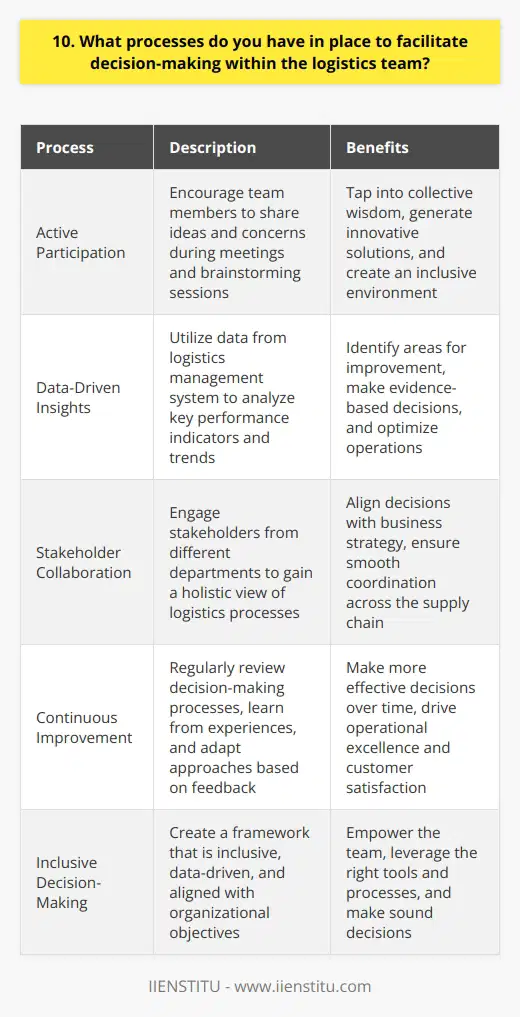
11. How do you foster a culture of accountability and responsibility among team members?
Fostering a culture of accountability and responsibility among team members is crucial for any organization's success. In my experience, it starts with clear communication and setting well-defined goals and expectations. When everyone understands their roles and how their work contributes to the bigger picture, they're more likely to take ownership of their tasks.
Lead by Example
As a leader, I believe in leading by example. I hold myself accountable first and foremost. When team members see their manager taking responsibility for their actions and decisions, it sets the tone for the entire team. It's about creating a culture where it's okay to make mistakes, as long as we learn from them and take steps to prevent them in the future.
Encourage Open Communication
I also prioritize open communication and regular check-ins with my team. This helps me stay informed about their progress, challenges, and concerns. By creating a safe and supportive environment where people feel comfortable speaking up, we can address issues early on and work together to find solutions.
Provide Resources and Support
Another key aspect is ensuring that team members have the resources and support they need to succeed. This includes proper training, tools, and guidance. When people feel empowered and equipped to do their best work, they're more likely to take ownership and be accountable for their results.
Celebrate Successes and Learn from Failures
Finally, I believe in celebrating successes and learning from failures as a team. When we achieve our goals, it's important to recognize everyone's contributions and share the credit. And when things don't go as planned, we need to analyze what went wrong without placing blame, and use it as an opportunity to improve our processes and grow as a team.
At the end of the day, fostering accountability and responsibility is about building trust, setting clear expectations, and creating a positive team culture where everyone feels valued and motivated to do their best work.
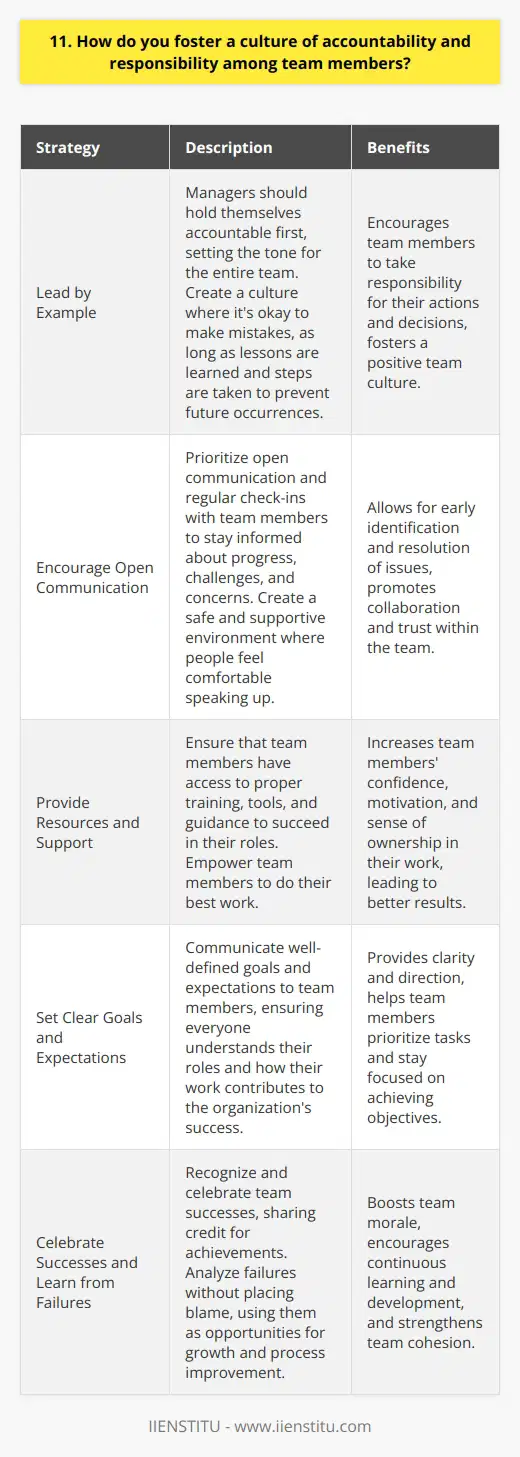
12. What strategies do you use to promote cross-functional collaboration with other departments?
I believe that effective cross-functional collaboration is essential for the success of any organization. To promote this, I focus on building strong relationships with colleagues in other departments through regular communication and active listening. I make an effort to understand their goals, challenges, and priorities, so we can find common ground and work together effectively.
Strategies for Collaboration
1. Establish Clear Communication Channels
I set up regular meetings, both formal and informal, to keep everyone informed and aligned. This could involve weekly status updates, project kickoffs, or even casual coffee chats to build rapport. I also leverage collaboration tools like Slack or Microsoft Teams to ensure seamless communication across departments.
2. Foster a Culture of Transparency and Trust
I believe in being open and honest about my work, challenges, and successes. By sharing information freely and encouraging others to do the same, we can build trust and create a more collaborative environment. When issues arise, I address them head-on with empathy and a solutions-oriented mindset.
3. Seek Out Opportunities for Cross-Functional Projects
Whenever possible, I look for ways to involve other departments in my projects or initiatives. This could mean inviting them to brainstorming sessions, seeking their input on key decisions, or even co-leading a project together. By working side-by-side, we can break down silos and foster a more collaborative culture.
The Benefits of Collaboration
In my experience, effective cross-functional collaboration leads to better outcomes for everyone involved. By leveraging diverse perspectives and skill sets, we can develop more innovative solutions and avoid potential roadblocks down the line. Plus, working closely with colleagues from other departments helps me grow professionally and expand my own knowledge and expertise.
At the end of the day, I believe that collaboration is key to driving business success. By focusing on building strong relationships, communicating effectively, and seeking out opportunities to work together, I strive to be a collaborative partner and contribute to the overall success of the organization.

13. How do you ensure that team members are aware of and adhere to company policies and procedures?
As a team leader, I believe in leading by example and fostering open communication within the team. I make sure to clearly explain company policies and procedures during onboarding and regular team meetings. I encourage team members to ask questions and voice any concerns they may have.
Regularly Reviewing Policies and Procedures
I schedule periodic reviews of key policies and procedures to ensure everyone is on the same page. During these sessions, we discuss any updates or changes and how they impact our day-to-day work. I find that having an open dialogue helps reinforce the importance of adhering to these guidelines.
Addressing Issues Promptly
If I notice a team member struggling to follow a particular policy or procedure, I address it promptly. I prefer to have a one-on-one conversation to understand their perspective and provide guidance and support. I believe in working collaboratively to find solutions rather than resorting to punitive measures.
Encouraging Accountability
I strive to create a culture of accountability within the team. I encourage team members to take ownership of their work and hold themselves and each other accountable for following company policies. When someone goes above and beyond in adhering to these guidelines, I make sure to recognize and appreciate their efforts.
At the end of the day, I believe that clear communication, regular reinforcement, and a supportive team environment are key to ensuring compliance with company policies and procedures.
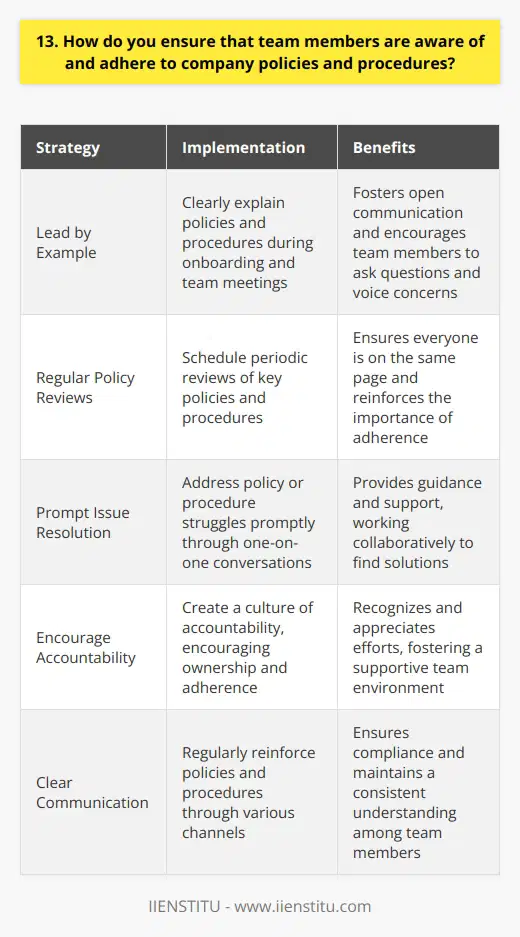
14. What methods do you employ to identify and develop leadership potential within your logistics team?
I employ several methods to identify and develop leadership potential within my logistics team. First, I observe each team member's performance, taking note of their strengths, weaknesses, and unique skills. This helps me determine who has the aptitude for leadership roles.
Providing Growth Opportunities
I believe in providing growth opportunities to my team members. I assign them tasks that challenge them and allow them to showcase their leadership abilities. For example, I might put someone in charge of a small project or have them mentor a new employee.
Encouraging Open Communication
Open communication is key to identifying leadership potential. I encourage my team to share their ideas, concerns, and aspirations with me. Through one-on-one conversations, I gain valuable insights into their goals and motivations.
Offering Training and Development
When I spot someone with leadership potential, I invest in their growth. I offer them training and development opportunities to enhance their skills. This might include workshops, seminars, or even mentorship programs with experienced leaders in our company.
Empowering Decision-Making
I empower my team members to make decisions within their roles. By giving them autonomy, I can see how they handle responsibility and make judgments. Those who consistently make sound decisions and take ownership of their work demonstrate strong leadership potential.
Ultimately, my goal is to create a supportive environment where every team member has the opportunity to grow and develop their leadership skills. By nurturing their potential, I can build a strong, capable team that drives our logistics operations forward.
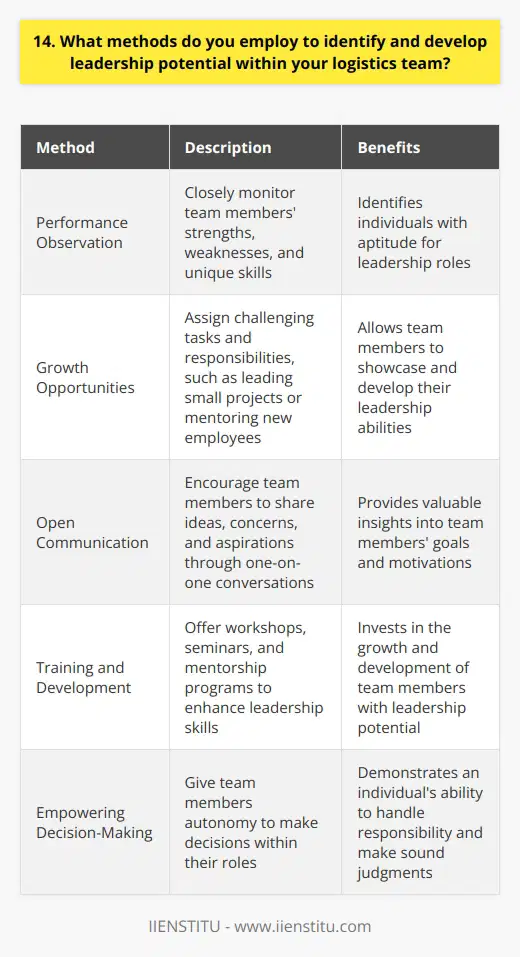
15. How do you encourage open and honest feedback among team members?
I believe that open and honest feedback is crucial for the success of any team. It fosters trust, encourages growth, and helps identify areas for improvement. Here are some ways I encourage open and honest feedback among team members:
Lead by Example
As a leader, I make it a point to provide constructive feedback to my team members regularly. I do this in a respectful and supportive manner, focusing on their strengths while also addressing areas where they can improve. By showing that I value feedback and am willing to give it, I create an environment where others feel comfortable doing the same.
Create a Safe Space
I work to create a safe and non-judgmental space where team members feel comfortable sharing their thoughts and opinions. This means actively listening to their concerns, ideas, and feedback without interrupting or becoming defensive. I also make sure to thank them for their honesty and assure them that their feedback is valued and will be acted upon.
Encourage Regular Check-Ins
I schedule regular one-on-one meetings with each team member to discuss their progress, challenges, and goals. During these check-ins, I ask open-ended questions and encourage them to share their thoughts and feelings. This helps build rapport and trust, making it easier for them to provide honest feedback.
Implement Feedback
When team members provide feedback, I make sure to follow through and implement changes where necessary. This shows them that their opinions matter and that I am committed to creating a better working environment for everyone. It also encourages them to continue providing feedback in the future.
By fostering a culture of open and honest feedback, I believe that teams can work more effectively, collaboratively, and creatively. It's not always easy, but it's always worth it in the end.

16. What steps do you take to ensure that team members are aligned with the company's overall mission and values?
As a leader, I take several steps to ensure team members are aligned with the company's mission and values. First and foremost, I lead by example. I embody our core values in my daily work and interactions. This sets the tone for the entire team.
Frequent Communication
I communicate the mission and values regularly in team meetings, one-on-ones, and even casual conversations. We discuss how our projects and tasks tie into the bigger picture. I encourage questions and dialogue to ensure understanding.
Collaborative Goal Setting
When setting goals and objectives, I involve the team. We map out how our targets align with company priorities. This collaborative process builds buy-in and commitment.
Recognition and Feedback
I recognize and praise team members who exemplify our values. Public acknowledgment reinforces the behaviors we want to see. Conversely, if I observe misalignment, I provide constructive feedback promptly. We work together to get back on track.
Hiring and Onboarding
Alignment starts with hiring people who resonate with our mission. During interviews, I assess candidates' fit with our culture. New hire orientation emphasizes our values and how they translate into expectations.
Continuous Reinforcement
Sustaining alignment requires ongoing effort. I weave our mission and values into decision making, problem solving, and celebrations. It's not a one-time event, but a continuous thread in our team's journey.
By taking these steps consistently, I've seen my teams develop a strong sense of purpose and unity. We're not just working on tasks, but toward a shared vision we all believe in.
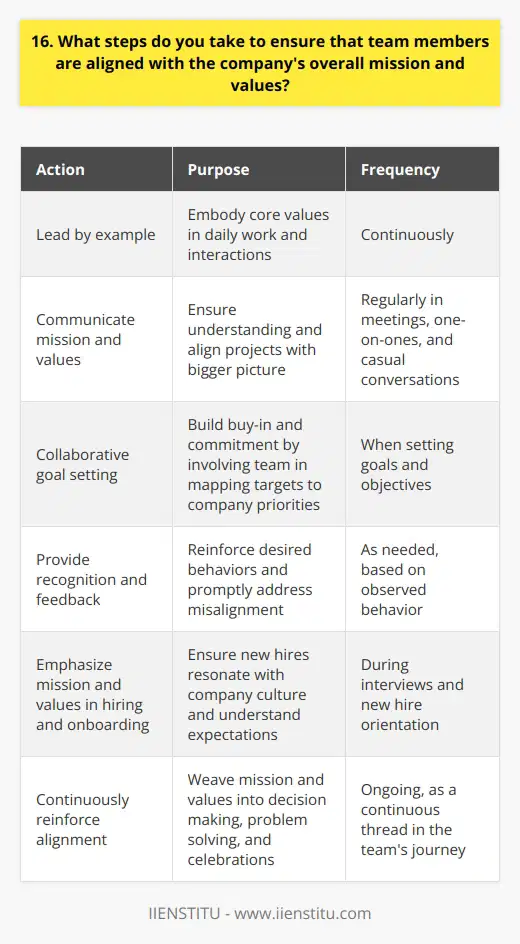
17. How do you facilitate knowledge sharing and best practice exchange within the logistics team?
As a logistics professional, I believe that facilitating knowledge sharing and best practice exchange within the team is crucial for success. Here are some strategies I use to ensure that everyone is on the same page and continuously improving:
Encourage Open Communication
I strive to create an environment where team members feel comfortable sharing their ideas and experiences. Whether it's through regular team meetings, one-on-one conversations, or even casual chats over coffee, I make sure that everyone has a chance to contribute and learn from each other.
Lead by Example
I believe that as a leader, it's important to model the behavior you want to see in your team. That's why I make a point of sharing my own knowledge and experiences, and actively seeking out opportunities to learn from others. By showing that I'm committed to continuous learning and improvement, I inspire my team to do the same.
Leverage Technology
In today's fast-paced business environment, technology can be a powerful tool for facilitating knowledge sharing. I make sure that my team has access to the latest logistics software and tools, and I encourage them to use collaborative platforms like Slack or Microsoft Teams to share information and ideas in real-time.
Recognize and Reward Knowledge Sharing
Finally, I believe that it's important to recognize and reward team members who go above and beyond in sharing their knowledge and expertise. Whether it's through public recognition, bonuses, or other incentives, I make sure that my team knows that their contributions are valued and appreciated.
By implementing these strategies, I've been able to create a culture of continuous learning and improvement within my logistics team. And the results speak for themselves - we consistently meet or exceed our performance targets, and have a reputation for being one of the most efficient and effective teams in the company.
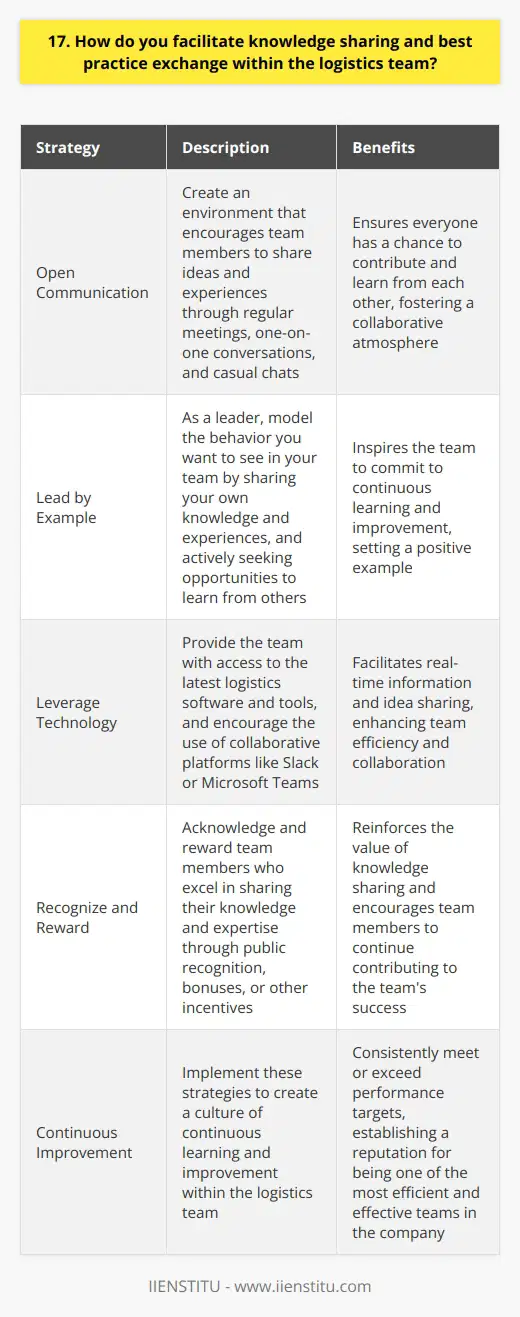
18. What techniques do you use to manage and prioritize competing priorities within the team?
As a team leader, I've developed several techniques to effectively manage and prioritize competing priorities within my team:
Regular Communication
I believe open and frequent communication is key. I hold daily stand-up meetings to discuss current tasks and roadblocks. This helps me stay informed about what everyone is working on and identify potential conflicts early.
Additionally, I have an open-door policy and encourage team members to come to me with any concerns. By maintaining open lines of communication, I can quickly address issues and keep projects on track.
Clear Goal Setting
I work with my team to set clear, measurable goals for each project. We break larger goals down into smaller, actionable tasks. This allows us to focus on the most important priorities and ensures everyone understands their responsibilities.
When new requests come in, I evaluate them against our current goals and priorities. If a request doesn't align with our objectives or would significantly derail our progress, I'm not afraid to push back and negotiate alternative solutions.
Flexible and Adaptable
Despite my best efforts, unexpected issues can always arise. That's why I remain flexible and adaptable in my approach. If priorities shift or an emergency occurs, I quickly reassess and adjust our plan as needed.
I also empower my team to be flexible. I trust their judgment and give them the autonomy to make decisions when necessary. This allows us to be more agile and responsive to changing needs.
By using these techniques, I'm able to effectively manage competing priorities, keep my team focused, and consistently deliver high-quality results, even in dynamic and fast-paced environments.
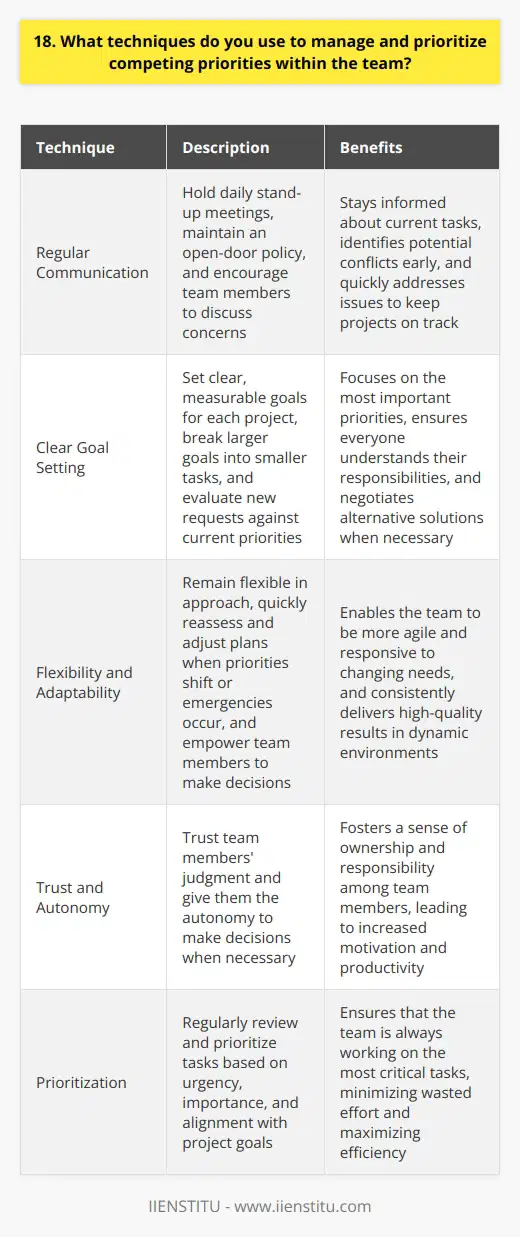
19. How do you ensure that team members are aware of and prepared for changes in the logistics industry?
As a logistics manager, I understand the importance of keeping team members informed and prepared for industry changes. I believe that open communication and ongoing training are key to ensuring a smooth transition during times of change.
Regular Team Meetings
I make it a priority to hold regular team meetings where we discuss upcoming changes and their potential impact. During these meetings, I encourage open dialogue and questions to ensure everyone is on the same page. I also use this time to gather feedback and ideas from team members, as they are often the ones closest to the day-to-day operations.
Targeted Training Sessions
When significant changes are on the horizon, I organize targeted training sessions to equip team members with the necessary skills and knowledge. These sessions may include workshops, seminars, or hands-on training with new technologies or processes. By investing in our team's development, we can adapt more quickly and effectively to industry shifts.
Collaboration with Other Departments
I believe in fostering collaboration between logistics and other departments, such as sales and customer service. By working closely with these teams, we can better anticipate and prepare for changes that may affect our customers. Regular cross-functional meetings help ensure that everyone is aligned and working towards the same goals.
Embracing Technology
In today's fast-paced logistics industry, embracing technology is crucial for staying ahead of the curve. I actively seek out new tools and systems that can streamline our processes and improve efficiency. When implementing new technology, I ensure that team members receive adequate training and support to maximize its potential.
By fostering a culture of open communication, continuous learning, and adaptability, I believe we can successfully navigate the ever-changing landscape of the logistics industry. It's not always easy, but by working together and staying proactive, we can turn challenges into opportunities for growth and success.
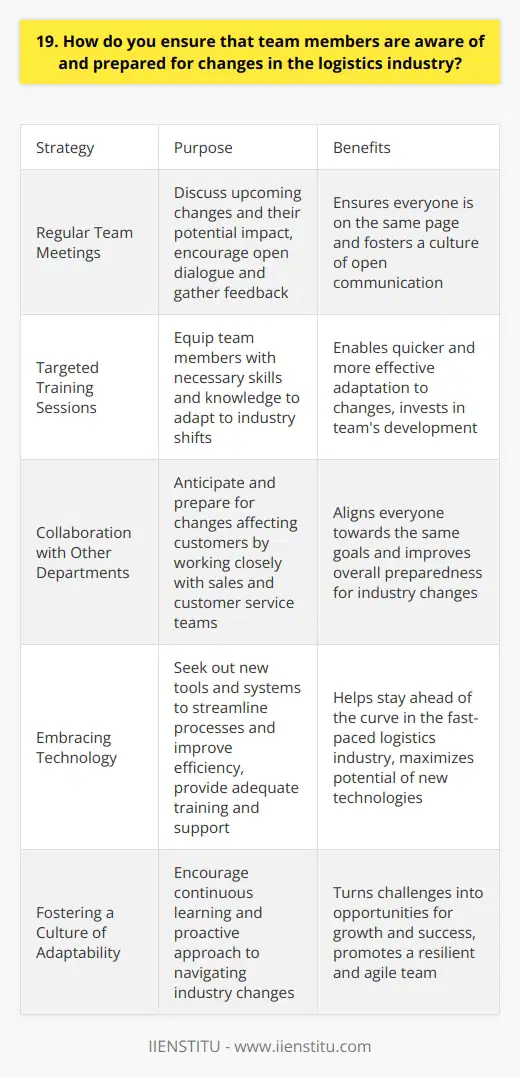
20. What processes do you have in place to recognize and reward exceptional team performance?
At our company, we believe in celebrating and rewarding exceptional team performance. We have several processes in place to ensure that outstanding work is recognized and appreciated.
Regular Performance Reviews
We conduct performance reviews on a quarterly basis. During these reviews, managers highlight the accomplishments and contributions of each team member. They provide specific examples of how individuals have gone above and beyond in their roles.
Peer Recognition Program
We have implemented a peer recognition program where teammates can nominate each other for exceptional work. This allows us to celebrate the successes and efforts of our colleagues, fostering a positive and supportive work environment.
Employee of the Month Award
Each month, we select an employee who has demonstrated outstanding performance and embodied our company values. The winner receives a special prize and is featured in our company newsletter, showcasing their achievements to the entire organization.
Annual Bonuses and Promotions
At the end of each year, we evaluate the overall performance of our teams. Top-performing individuals are rewarded with bonuses and considered for promotions, recognizing their hard work and dedication to the company's success.
I remember a time when my team worked tirelessly on a challenging project. We put in long hours and collaborated closely to meet a tight deadline. When we successfully delivered the project, our manager organized a special team celebration to acknowledge our efforts. It felt incredible to have our hard work recognized and appreciated by both our manager and our peers.
In my opinion, recognizing and rewarding exceptional team performance is crucial for employee morale and engagement. When people feel valued and appreciated, they are more likely to go the extra mile and continue delivering their best work.
At our company, we strive to create a culture of recognition and appreciation. By implementing these processes and celebrating our successes together, we foster a positive and motivated workforce that drives our organization forward.
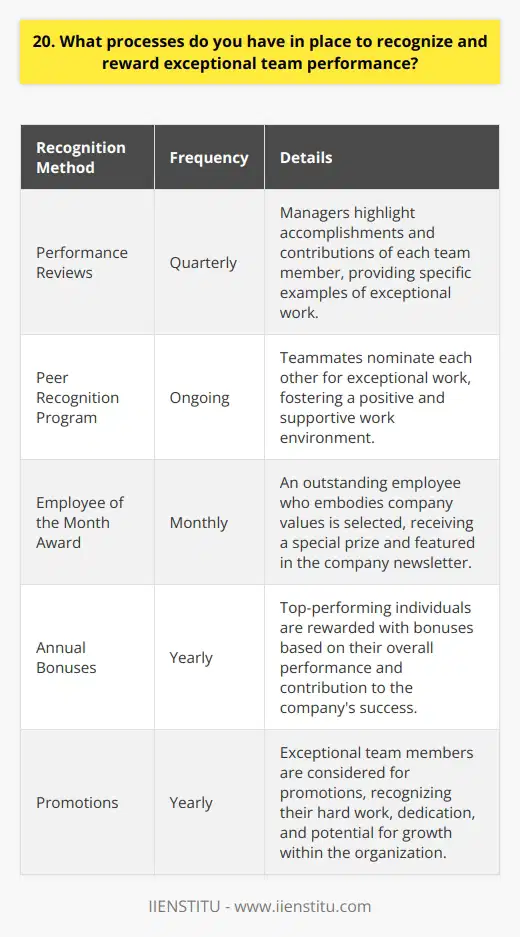
21. How do you foster a culture of diversity and inclusion within your logistics team?
As a logistics manager, I believe that fostering a culture of diversity and inclusion is crucial for success. I actively seek out team members from various backgrounds and experiences to bring fresh perspectives. By encouraging open communication and valuing every individual's unique contributions, I create an environment where everyone feels heard and respected.
Celebrating Differences
I love learning about my team members' diverse cultures, traditions, and viewpoints. We often share stories and insights during team-building activities, which helps us appreciate our differences and find common ground. When everyone feels comfortable being their authentic selves at work, it boosts morale and collaboration.
Inclusive Decision-Making
I make sure to involve my entire team in key decisions and problem-solving. By seeking input from people with different skill sets and experiences, we generate more creative solutions. Even if an idea seems unconventional at first, I encourage my team to explore it fully before dismissing it.
Continuous Learning
To promote inclusivity, I invest in ongoing diversity and sensitivity training for myself and my team. We learn how to recognize and overcome unconscious biases, communicate effectively across differences, and create a welcoming environment for all. I also partner with HR to ensure our hiring and promotion practices are fair and equitable.
Leading by Example
I strive to model inclusive behavior in my daily interactions with team members, clients, and partners. I speak up if I witness any discriminatory or disrespectful conduct, and I work to resolve conflicts constructively. By setting a positive example, I hope to inspire my team to embrace diversity as a strength.
Ultimately, I believe that building a diverse and inclusive logistics team is not only the right thing to do - it's also good for business. When everyone feels valued and empowered to contribute their best, we achieve better results together.

22. What strategies do you use to manage and mitigate risks within the logistics operation?
I employ several strategies to effectively manage and mitigate risks within the logistics operation. First and foremost, I prioritize clear communication and collaboration with all stakeholders involved in the supply chain process. This ensures everyone is on the same page and potential issues can be identified and addressed proactively.
Risk Assessment and Contingency Planning
Conducting thorough risk assessments is crucial. I analyze past data, current trends, and potential future scenarios to identify potential risks. Based on these assessments, I develop comprehensive contingency plans that outline steps to take in case of disruptions or emergencies. Having a well-defined plan of action minimizes the impact of risks on the logistics operation.
Continuous Monitoring and Adaptation
I believe in the importance of continuous monitoring and adaptation. I closely track key performance indicators and stay vigilant for any signs of potential issues. If a problem arises, I quickly assess the situation and take necessary actions to mitigate the risk. I'm not afraid to adjust plans and strategies as needed to ensure the smooth flow of the logistics operation.
Strong Vendor Relationships and Diversification
Building strong relationships with reliable vendors is essential. I carefully select vendors who have a proven track record of quality and reliability. Additionally, I prioritize vendor diversification to reduce the risk of relying on a single supplier. By having multiple trusted vendors, I can ensure a steady supply of goods even if one vendor experiences issues.
Leveraging Technology for Risk Mitigation
I leverage advanced technology solutions to enhance risk management. By utilizing real-time tracking systems, I can monitor shipments and quickly identify any delays or deviations. Predictive analytics help me anticipate potential risks and take proactive measures. Technology also enables me to have real-time visibility into inventory levels, ensuring we can meet customer demands while minimizing the risk of stockouts.
In summary, my approach to risk management in logistics involves clear communication, thorough risk assessments, continuous monitoring, strong vendor relationships, diversification, and leveraging technology. By employing these strategies, I can effectively mitigate risks and ensure the smooth operation of the logistics process.

23. How do you ensure that team members are compliant with relevant regulations and standards?
As a team leader, I prioritize staying up-to-date with the latest regulations and standards relevant to our work. I regularly review official sources and attend training sessions to ensure I have a thorough understanding of what's required.
Communicating Expectations Clearly
I make it a point to clearly communicate regulatory requirements and expectations to my team members. In team meetings and one-on-one check-ins, I explain what standards we need to meet and why they matter. I also share helpful resources and am always available to answer questions.
Providing Necessary Training
Whenever there are updates to regulations or new team members join, I facilitate training sessions. I believe in equipping the team with the knowledge and skills to confidently meet standards. We do hands-on exercises to solidify understanding.
Implementing Compliance Checks
To verify that we're staying compliant, I build systematic checks and audits into our processes. I have checklists that map to requirements, and team members initial when complete. This creates accountability and allows me to spot potential issues early.
Encouraging Questions and Feedback
Above all, I foster an environment where team members feel comfortable raising concerns or making suggestions. Compliance is a team effort. I encourage people to speak up if something seems off. Together, we work to find solutions and implement improvements to keep standards high.
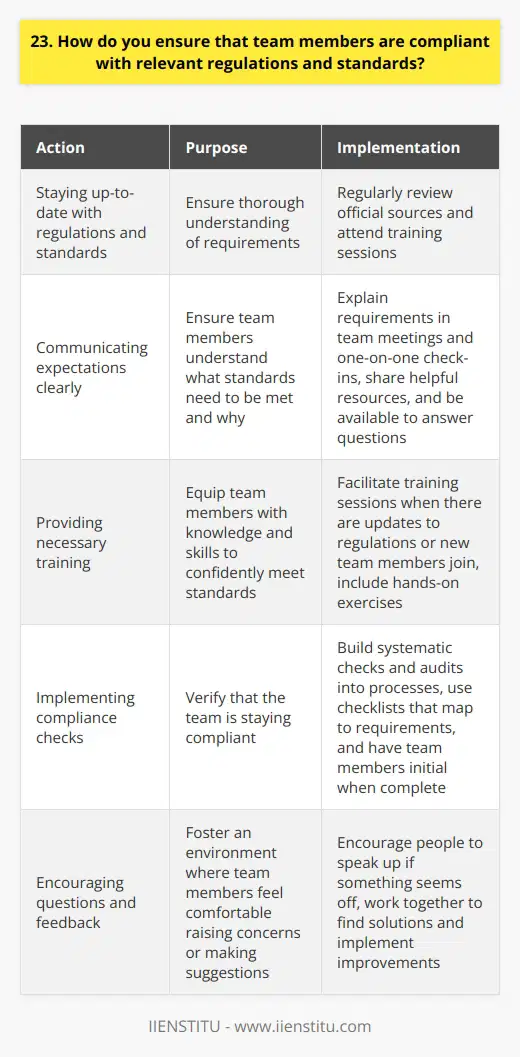
24. What methods do you employ to identify and address skills gaps within the logistics team?
I employ several methods to identify and address skills gaps within the logistics team:
Regular skills assessments
I conduct regular skills assessments to identify areas where team members may need additional training or support. These assessments help me pinpoint specific skills gaps and develop targeted training plans.
One-on-one meetings
I schedule one-on-one meetings with each team member to discuss their strengths, weaknesses, and career goals. These conversations provide valuable insights into individual skills gaps and help me tailor my management approach.
Cross-training opportunities
I encourage cross-training among team members to promote skill-sharing and address skills gaps. When a team member excels in a particular area, I ask them to train others, which helps bridge knowledge gaps and fosters a culture of continuous learning.
Performance metrics analysis
I analyze performance metrics to identify areas where the team may be struggling due to skills gaps. If I notice a pattern of errors or inefficiencies, I investigate further to determine if additional training or resources are needed.
Collaboration with HR
I work closely with our HR department to develop comprehensive training programs that align with our team's needs. By collaborating with HR, I can ensure that our skills development efforts are strategic and effective.
Ultimately, my goal is to create a proactive, supportive environment where team members feel empowered to grow and succeed. By consistently identifying and addressing skills gaps, I help my team stay agile, adaptable, and equipped to handle any challenge that comes our way.

25. How do you encourage team members to take ownership of their roles and responsibilities?
When it comes to encouraging team members to take ownership of their roles and responsibilities, I believe in leading by example. As a manager, I always strive to demonstrate a strong work ethic and commitment to my own tasks and projects. By setting a positive example, I find that team members are more likely to follow suit and take pride in their own work.
Effective Communication
I also prioritize open and transparent communication within the team. I make sure to clearly outline each team member's roles and responsibilities, and I encourage them to ask questions and provide feedback. By fostering an environment of open dialogue, team members feel more invested in their work and are more likely to take ownership of their tasks.
Empowering Team Members
Another key strategy I use is empowering team members to make decisions and take initiative within their roles. Rather than micromanaging, I give team members the autonomy to problem-solve and come up with creative solutions. This not only helps them develop their skills and confidence but also encourages them to take ownership of their work.
Recognizing Achievements
Finally, I believe in recognizing and rewarding team members for their hard work and accomplishments. Whether it's through verbal praise, bonuses, or opportunities for growth and development, acknowledging team members' contributions goes a long way in motivating them to continue taking ownership of their roles.
By combining these strategies of leading by example, communicating effectively, empowering team members, and recognizing achievements, I've found that teams become more engaged, motivated, and committed to their work. It's all about creating a positive and supportive work environment where everyone feels valued and invested in the success of the team.
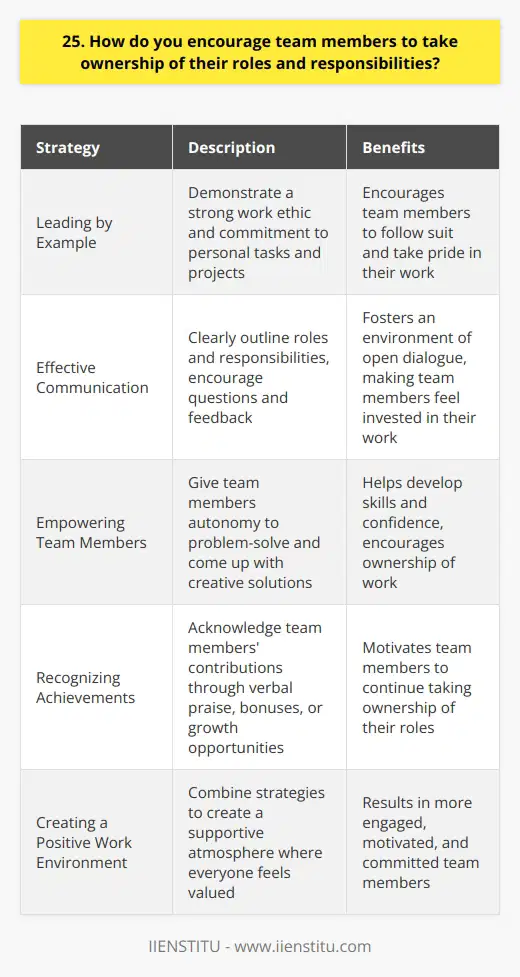
26. What steps do you take to ensure that team members are aware of and responsive to customer needs?
As a team leader, I take several steps to ensure that my team is aware of and responsive to customer needs. First and foremost, I emphasize the importance of active listening and empathy when interacting with customers. I encourage my team members to put themselves in the customer's shoes and understand their perspective.
Fostering Open Communication
I foster open communication within the team and with customers. We have regular team meetings where we discuss customer feedback, both positive and negative. This allows us to identify areas for improvement and brainstorm solutions together.
Providing Training and Resources
I provide my team with the necessary training and resources to effectively serve customers. This includes product knowledge, communication skills, and problem-solving techniques. I also make sure that they have access to the tools and information they need to address customer inquiries and concerns.
Leading by Example
I believe in leading by example. I make a point of being responsive to customer needs myself and demonstrating the behavior I expect from my team. When a customer raises an issue, I take ownership of it and work diligently to find a resolution.
Monitoring and Feedback
I regularly monitor customer interactions and provide feedback to my team members. If I notice areas where they can improve, I offer constructive criticism and guidance. I also make sure to recognize and praise team members who go above and beyond in serving customers.
Continuous Improvement
Finally, I foster a culture of continuous improvement. I encourage my team to share their ideas and suggestions for enhancing the customer experience. We regularly review our processes and look for ways to streamline and optimize them.
By taking these steps, I ensure that my team is always aware of and responsive to customer needs. It's not just about resolving individual issues, but creating a customer-centric culture that prioritizes satisfaction and loyalty.
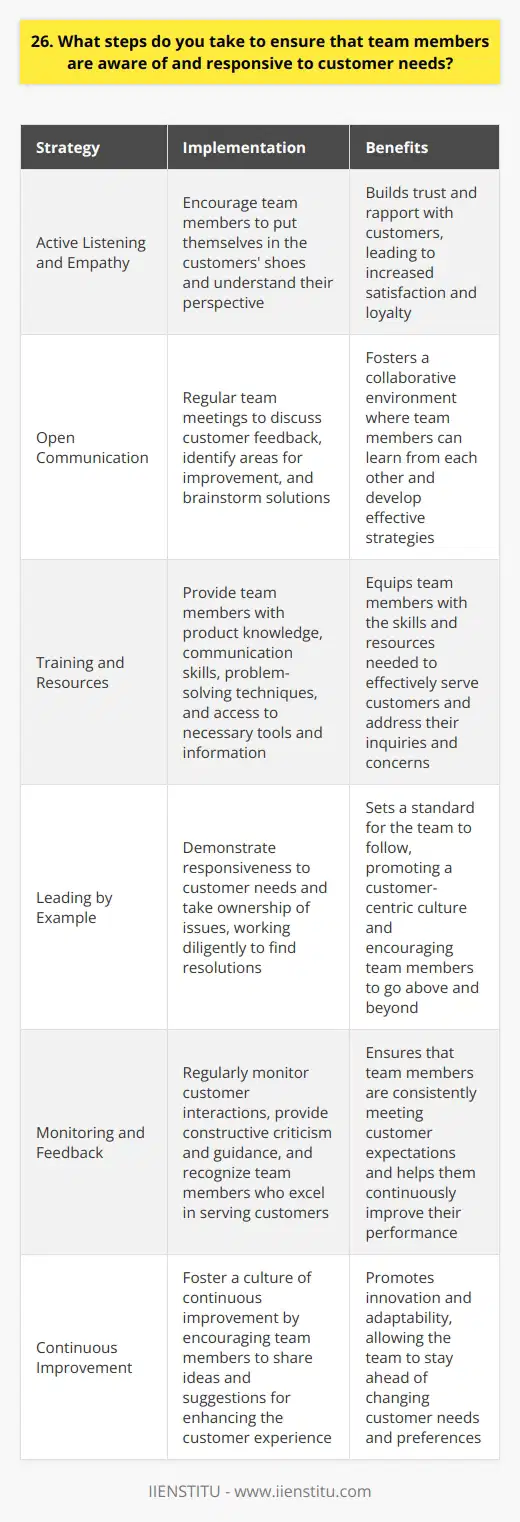
27. How do you facilitate effective problem-solving and decision-making within the logistics team?
I facilitate effective problem-solving and decision-making within the logistics team by first fostering open communication. I encourage team members to share their ideas, concerns, and suggestions freely. This creates a collaborative environment where everyone feels heard and valued.
Identifying the Root Cause
When a problem arises, I guide the team in identifying the root cause. We ask questions, gather data, and analyze the situation from various angles. By understanding the underlying issues, we can develop targeted solutions.
Brainstorming Solutions
Once we have a clear understanding of the problem, I facilitate brainstorming sessions. I encourage the team to think creatively and propose innovative solutions. We explore different approaches and weigh the pros and cons of each option.
Evaluating and Implementing Solutions
After generating potential solutions, I lead the team in evaluating their feasibility and effectiveness. We consider factors such as cost, time, resources, and potential risks. Once we reach a consensus, we develop an implementation plan with clear goals, timelines, and responsibilities.
Monitoring and Adjusting
Throughout the implementation process, I closely monitor progress and gather feedback from the team. If we encounter challenges or roadblocks, we adapt our approach and make necessary adjustments. I believe in continuous improvement and learning from our experiences.
By following this structured problem-solving approach and fostering a collaborative team environment, I have successfully led logistics teams in overcoming complex challenges. For example, in my previous role, we faced a significant delay in our supply chain due to a vendor issue. By working together, we identified alternative suppliers, negotiated expedited shipping, and ultimately delivered the products to our customers on time. It was a testament to the power of effective problem-solving and decision-making within a dedicated team.
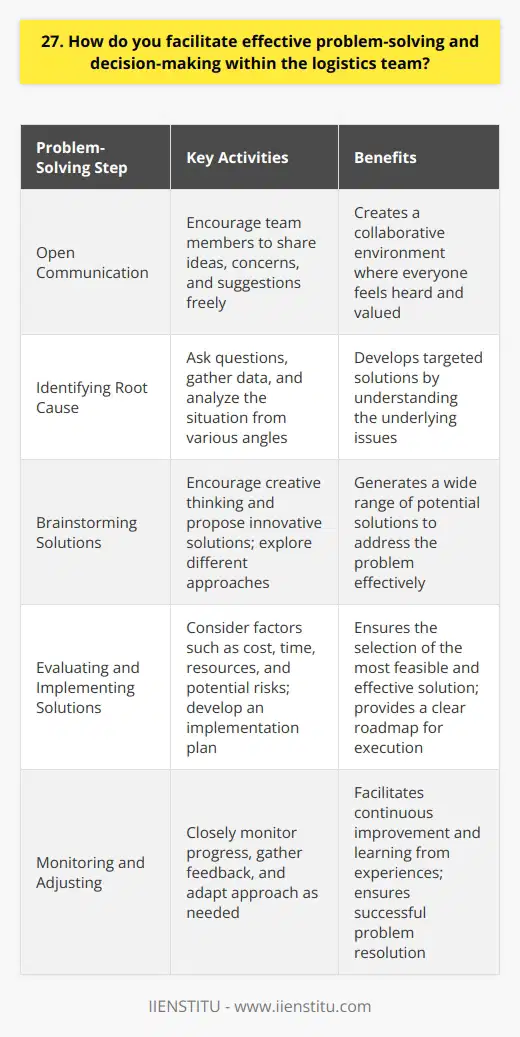
28. What techniques do you use to manage and optimize team resources and capacity?
As a team leader, I employ several techniques to effectively manage and optimize team resources and capacity:
Regularly assess team workload and capacity
I frequently check in with each team member to understand their current workload and availability. This helps me identify any potential bottlenecks or overallocation of resources, allowing me to proactively address these issues.
Prioritize tasks and allocate resources accordingly
Based on the team's goals and deadlines, I prioritize tasks and allocate resources to ensure that the most critical projects receive the necessary attention. I also consider each team member's strengths and expertise when assigning tasks to maximize efficiency and quality of work.
Foster open communication and collaboration
I encourage open communication within the team, promoting a culture of transparency and collaboration. By creating an environment where team members feel comfortable sharing their progress, challenges, and ideas, we can collectively problem-solve and support each other to optimize our resources and capacity.
Continuously monitor and adjust plans
I closely monitor the team's progress and performance, making adjustments to our plans and resource allocation as needed. This agile approach allows us to quickly adapt to changes in priorities, deadlines, or unforeseen circumstances, ensuring that we remain on track and deliver high-quality results.
By implementing these techniques, I have successfully led teams to optimize their resources and capacity, ultimately achieving our goals and delivering exceptional results.
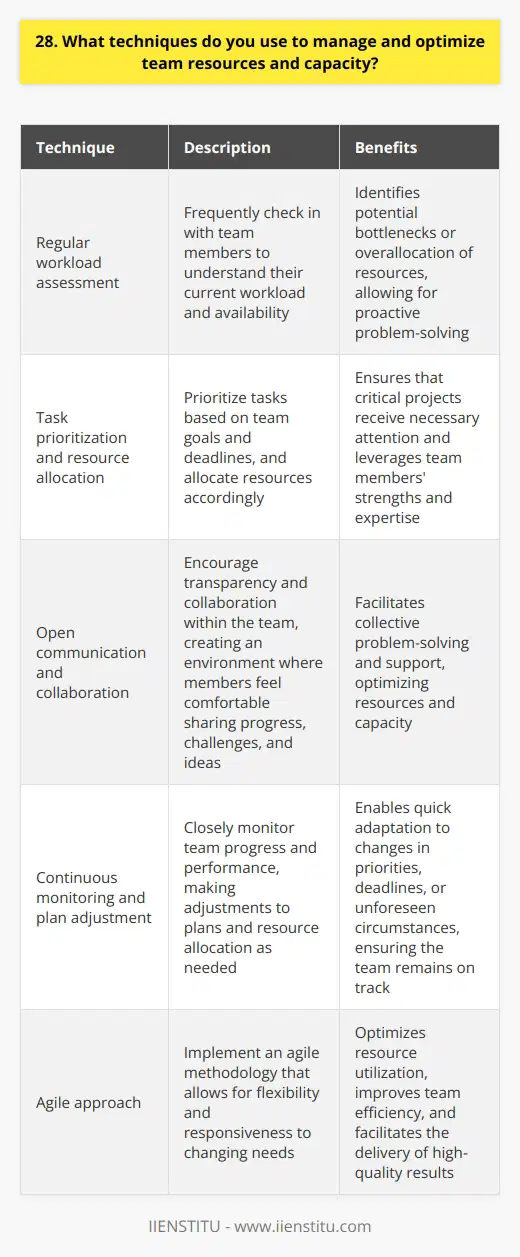
29. How do you ensure that team members are aware of and aligned with key performance indicators?
I ensure team members are aware of and aligned with key performance indicators through regular communication and collaboration. I start by clearly defining the KPIs and how they contribute to the company's goals. Then, I break them down into specific, measurable targets for each team member.
Frequent Check-Ins and Updates
I schedule frequent check-ins with the team to discuss progress, challenges, and any necessary adjustments. These meetings provide an opportunity to realign priorities and ensure everyone is on the same page. I also send regular updates via email or our project management tool to keep KPIs top of mind.
Visual Dashboards and Scorecards
I create visual dashboards and scorecards that display real-time data on our KPIs. These tools make it easy for team members to see how their individual efforts impact the bigger picture. They also foster a sense of accountability and healthy competition among the team.
Celebrating Successes and Learning from Setbacks
When we hit our KPI targets, I make sure to celebrate those successes as a team. Recognition and rewards reinforce the importance of the KPIs and motivate everyone to keep striving for excellence. If we fall short, I use it as a learning opportunity to identify areas for improvement and adjust our strategies accordingly.
By consistently communicating, monitoring progress, and involving the team in the process, I maintain alignment with our KPIs. It's an ongoing effort, but one that pays off in terms of better performance and results.
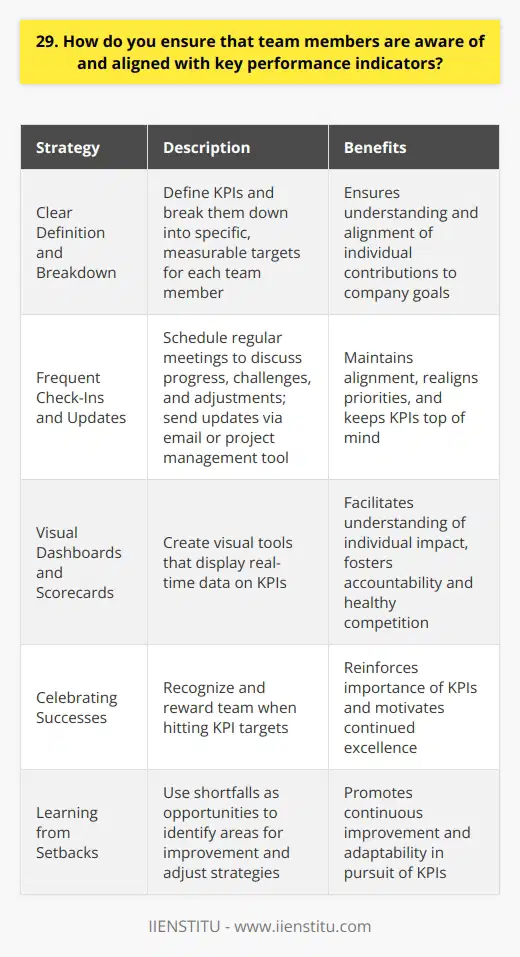
30. What processes do you have in place to continuously assess and improve team alignment and performance?
As a team leader, I believe in fostering open communication and regularly checking in with my team members. I encourage everyone to share their thoughts, concerns, and suggestions during our weekly team meetings. This helps me gauge the team's alignment and identify any issues that need to be addressed.
Setting Clear Goals and Expectations
I work with my team to set clear, measurable goals that align with the company's objectives. By ensuring that everyone understands their roles and responsibilities, we can work together more effectively and efficiently.
Providing Feedback and Support
I believe in providing regular feedback to my team members, both positive and constructive. This helps them grow professionally and keeps them motivated. I also make sure to offer support and resources whenever needed, so they can perform at their best.
Encouraging Continuous Learning
I'm a strong advocate for continuous learning and development. I encourage my team to attend workshops, conferences, and training sessions to enhance their skills and knowledge. This not only benefits them individually but also contributes to the overall performance of the team.
Measuring Performance and Adjusting Strategies
I regularly assess the team's performance using key metrics and KPIs. If we're not meeting our goals, I work with the team to identify the root causes and adjust our strategies accordingly. By continuously monitoring and improving our processes, we can ensure that we're always aligned and performing at our best.


